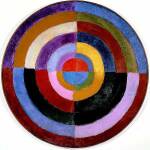Josef Albers (1888–1976) was a German-American artist, educator, and influential figure in the fields of color theoryColor Theory is a comprehensive framework used to understand and analyze the use and interaction of colors in visual compositions. It serves as a critical guide for artists, designers, and marketers, helping them create harmonious and effective designs. This concept encompasses various principles and elements that dictate how colors are combined, perceived, and utilized. Primary Colors: • The three foundational More and abstract art Abstract artworks diverge from depicting recognizable scenes or objects and instead use colors, forms, and lines to create compositions that exist independently of visual references from the natural world. This movement, which gained momentum in the early 20th century, was propelled by artists such as Wassily Kandinsky, Piet Mondrian, and Kazimir Malevich. These artists aimed to explore spiritual, emotional, and More. Known for his profound impact on modern art education, Albers’ work emphasized the perception and interaction of color.
Abstract artworks diverge from depicting recognizable scenes or objects and instead use colors, forms, and lines to create compositions that exist independently of visual references from the natural world. This movement, which gained momentum in the early 20th century, was propelled by artists such as Wassily Kandinsky, Piet Mondrian, and Kazimir Malevich. These artists aimed to explore spiritual, emotional, and More. Known for his profound impact on modern art education, Albers’ work emphasized the perception and interaction of color.
Born in Bottrop, Germany, Albers initially trained as a schoolteacher before pursuing his passion for art. He studied at the BauhausThe Bauhaus movement originated as a German school of the arts in the early 20th century. Founded by German architect Walter Gropius in 1919, the school was dedicated to uniting all branches of the arts under one roof. The Bauhaus acted as a hub for Europe's most experimental creatives, with well-known artist instructors like Wassily Kandinsky, Josef Albers, and Paul More, where he later became a faculty member, and eventually emigrated to the United States, continuing his teaching and artistic practice.

- Key Contributions:
- Authored “Interaction of Color”
- Developed the Homage to the Square series
- Taught at the BauhausThe Bauhaus movement originated as a German school of the arts in the early 20th century. Founded by German architect Walter Gropius in 1919, the school was dedicated to uniting all branches of the arts under one roof. The Bauhaus acted as a hub for Europe's most experimental creatives, with well-known artist instructors like Wassily Kandinsky, Josef Albers, and Paul More, Black Mountain College, and Yale University
Interaction of Color: In his seminal work “Interaction of Color” (1963), Albers explored how colors influence one another and how they are perceived in various contexts. This book, filled with practical exercises, remains a cornerstone of color education.
- Key Concepts:
- Color relativity: how the perception of a color is affected by adjacent colors
- Practical exercises for understanding color interaction
- Demonstrations of optical illusions created by color
Albers’ emphasis on experiential learning allowed students to discover the complexities of color relationships through direct experimentation.
Homage to the Square: Albers is perhaps best known for his “Homage to the Square” series, a collection of paintings focusing on the interaction of nested squares. Through these works, he demonstrated his theories of color perception and interaction.
- Artistic Focus:
- Exploration of color relationships within a uniform format
- Use of nested squares to study color dynamics
- Demonstration of how colors can change perception based on context
The series highlighted the variability of color perception and the importance of context in visual art.
Teaching and Educational Impact: Albers’ teaching career spanned several prestigious institutions. At the BauhausThe Bauhaus movement originated as a German school of the arts in the early 20th century. Founded by German architect Walter Gropius in 1919, the school was dedicated to uniting all branches of the arts under one roof. The Bauhaus acted as a hub for Europe's most experimental creatives, with well-known artist instructors like Wassily Kandinsky, Josef Albers, and Paul More, Black Mountain College, and later at Yale University, he influenced a generation of artists and designers with his innovative approaches to art education.
- Educational Philosophy:
- Emphasized hands-on learning and experimentation
- Encouraged students to explore the subjective nature of color
- Integrated theory with practical application
His methods fostered a deep understanding of color and form, impacting students such as Robert Rauschenberg and Cy Twombly.
Optical and Color TheoryColor Theory is a comprehensive framework used to understand and analyze the use and interaction of colors in visual compositions. It serves as a critical guide for artists, designers, and marketers, helping them create harmonious and effective designs. This concept encompasses various principles and elements that dictate how colors are combined, perceived, and utilized. Primary Colors: • The three foundational More: Albers conducted extensive research into the optical effects of color. He believed that understanding these effects required not just theoretical knowledge but also practical experience.

- Optical Effects:
- Studied how colors interact to create visual phenomena
- Demonstrated how color can alter spatial perception
- Investigated the psychological impacts of color
His work provided valuable insights into the practical application of color theoryColor Theory is a comprehensive framework used to understand and analyze the use and interaction of colors in visual compositions. It serves as a critical guide for artists, designers, and marketers, helping them create harmonious and effective designs. This concept encompasses various principles and elements that dictate how colors are combined, perceived, and utilized. Primary Colors: • The three foundational More in art and design.
Artistic Practice: Beyond his theoretical contributions, Albers was an accomplished artist. His works, particularly those in the “Homage to the Square” series, are celebrated for their clarity, precision, and exploration of color dynamics.
- Artistic Style:
- Emphasis on geometric abstraction
- Focus on the interaction and perception of color
- Use of repetitive forms to explore visual effects
His art serves as a practical demonstration of his color theories, bridging the gap between theory and practice.
Influence and Legacy: Albers’ contributions to color theoryColor Theory is a comprehensive framework used to understand and analyze the use and interaction of colors in visual compositions. It serves as a critical guide for artists, designers, and marketers, helping them create harmonious and effective designs. This concept encompasses various principles and elements that dictate how colors are combined, perceived, and utilized. Primary Colors: • The three foundational More and art education have had a lasting impact. His teachings and writings continue to influence contemporary artists and educators, and his artworks are celebrated for their pioneering exploration of color.
- Impact:
- Revolutionized color education and theory
- Influenced modern art and design practices
- Left a legacy of integrating scientific and artistic approaches to color
Josef Albers’ work remains a fundamental part of art education and color theoryColor Theory is a comprehensive framework used to understand and analyze the use and interaction of colors in visual compositions. It serves as a critical guide for artists, designers, and marketers, helping them create harmonious and effective designs. This concept encompasses various principles and elements that dictate how colors are combined, perceived, and utilized. Primary Colors: • The three foundational More, demonstrating the profound effects of color interaction and perception.
